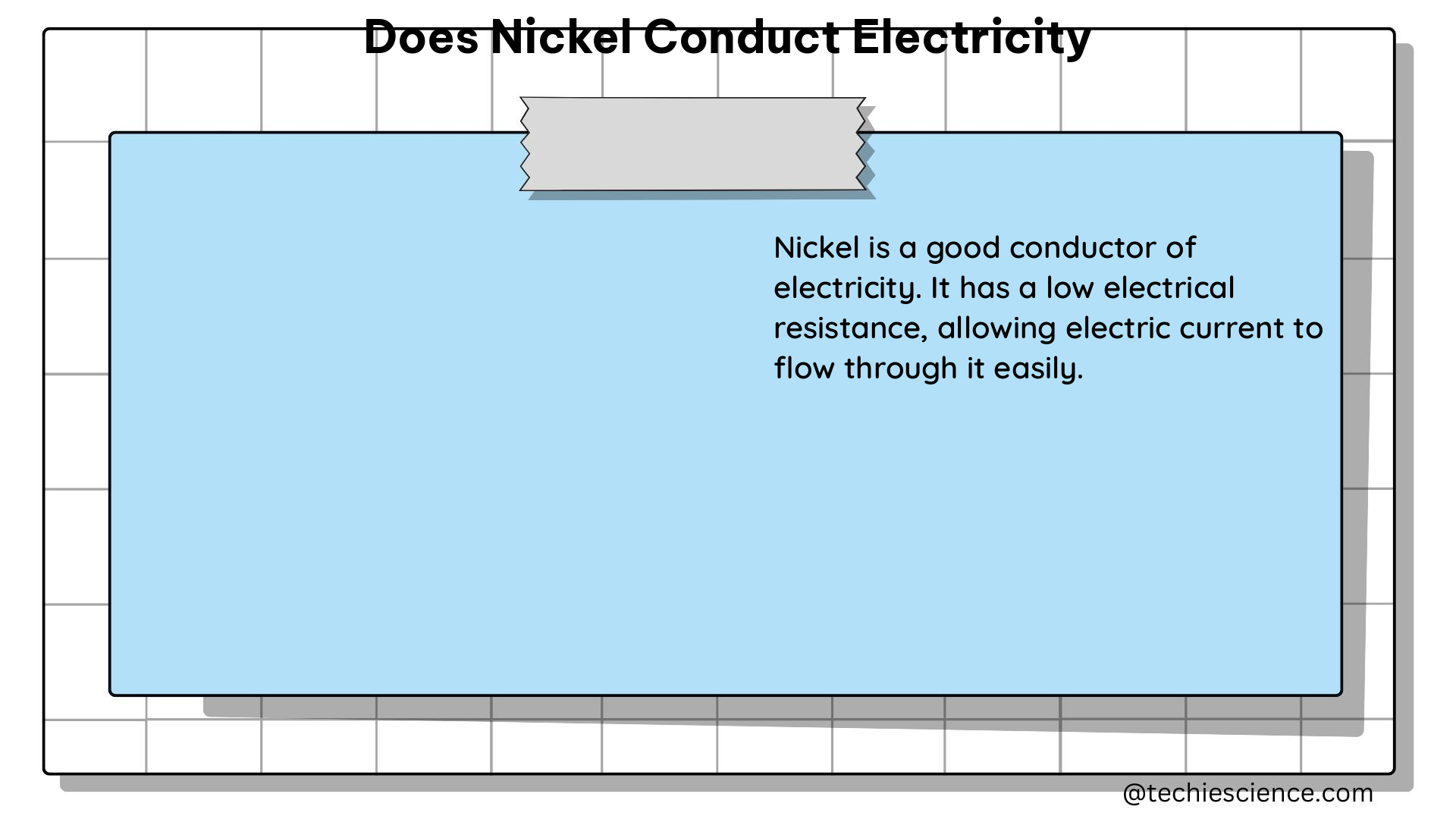Nickel is a metal that conducts electricity with a high degree of conductivity, making it a valuable material in various applications, such as electrical wiring, batteries, and electronics. This blog post will delve into the technical details of nickel’s electrical conductivity, exploring the factors that influence it and providing a comprehensive understanding of this important property.
Atomic Structure and Electrical Conductivity of Nickel
The electrical conductivity of nickel is primarily due to its atomic structure, which contains a large number of free electrons that can move freely within the metal. These free electrons are responsible for the efficient transmission of electric current through the material.
The electrical conductivity of a metal can be described by the Drude model, which states that the conductivity is proportional to the number of free electrons and their mobility. In the case of nickel, the free electrons are able to move easily through the metal’s crystal structure, allowing for the efficient flow of electric current.
The electrical conductivity of nickel can be quantified using the concept of electrical resistivity, which is the reciprocal of conductivity. The electrical resistivity of nickel at room temperature is approximately 6.84 x 10^-8 Ω·m, according to the data provided in the references.
Factors Affecting the Electrical Conductivity of Nickel

The electrical conductivity of nickel can be influenced by various factors, including temperature, impurities, crystal structure, electromagnetic fields, and frequency. Understanding these factors is crucial for optimizing the performance of nickel in electrical applications.
Temperature
The electrical conductivity of nickel is inversely proportional to temperature. As the temperature of nickel increases, the vibrations of the atoms in the crystal lattice increase, which can hinder the movement of free electrons and reduce the overall conductivity. This relationship can be described by the following equation:
σ = σ₀ / (1 + α(T – T₀))
Where:
– σ is the electrical conductivity at temperature T
– σ₀ is the electrical conductivity at reference temperature T₀
– α is the temperature coefficient of electrical resistivity
Impurities
The presence of impurities in nickel can also affect its electrical conductivity. Impurities can disrupt the crystal structure of nickel, creating defects that can scatter the free electrons and reduce their mobility. This can lead to an increase in the electrical resistivity of the material.
Crystal Structure
The crystal structure of nickel can also influence its electrical conductivity. Nickel typically has a face-centered cubic (FCC) crystal structure, but the presence of defects or variations in the crystal structure can alter the movement of free electrons and affect the overall conductivity.
Electromagnetic Fields
Exposure to strong electromagnetic fields can also impact the electrical conductivity of nickel. The interaction between the free electrons in nickel and the applied electromagnetic field can lead to the generation of eddy currents, which can oppose the flow of the primary electric current and reduce the overall conductivity.
Frequency
The electrical conductivity of nickel can also be affected by the frequency of the applied electric field. At high frequencies, the skin effect can become significant, where the electric current tends to flow closer to the surface of the material, reducing the effective cross-sectional area for conduction and decreasing the overall conductivity.
Practical Applications of Nickel’s Electrical Conductivity
The high electrical conductivity of nickel makes it a valuable material in various applications, including:
- Electrical Wiring: Nickel is often used in the production of electrical wiring and cables due to its ability to efficiently transmit electric current.
- Batteries: Nickel is a key component in the electrodes of rechargeable batteries, such as nickel-cadmium (NiCd) and nickel-metal hydride (NiMH) batteries, where its conductivity plays a crucial role in the battery’s performance.
- Electronics: Nickel is used in the manufacturing of electronic components, such as connectors, switches, and contacts, where its high conductivity is essential for reliable and efficient electrical connections.
- Corrosion-Resistant Coatings: Nickel-based coatings are often used to protect other metals from corrosion, as the conductivity of nickel can help to dissipate static electricity and prevent the buildup of corrosive agents.
Conclusion
In conclusion, nickel is a highly conductive metal that plays a crucial role in various electrical and electronic applications. Its electrical conductivity is primarily due to its atomic structure, which allows for the efficient movement of free electrons. However, the conductivity of nickel can be influenced by factors such as temperature, impurities, crystal structure, electromagnetic fields, and frequency. Understanding these factors is essential for optimizing the performance of nickel in electrical applications and developing new technologies that leverage its unique properties.
References
- Best Metals That Conduct Electricity
- Surprising Discovery Could Change the Way Industry Uses Nickel
- Electrical Conductivity
Hi…I am Ankita Biswas. I have done my B.Sc in physics Honours and my M.Sc in Electronics. Currently, I am working as a Physics teacher in a Higher Secondary School. I am very enthusiastic about the high-energy physics field. I love to write complicated physics concepts in understandable and simple words.